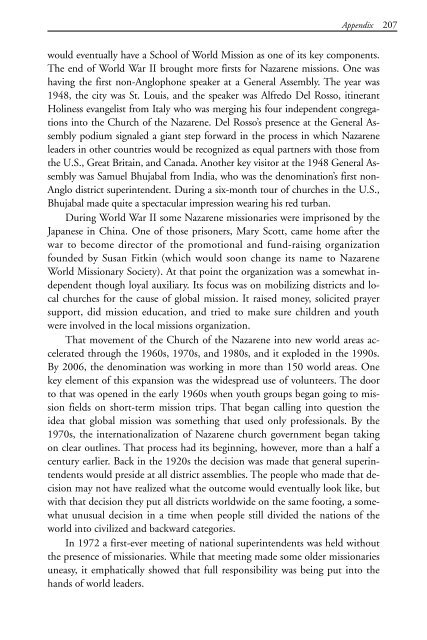discovering missions - Southern Nazarene University
discovering missions - Southern Nazarene University
discovering missions - Southern Nazarene University
Create successful ePaper yourself
Turn your PDF publications into a flip-book with our unique Google optimized e-Paper software.
245187 Disc Missions ins 9/6/07 1:04 PM Page 207<br />
Appendix 207<br />
would eventually have a School of World Mission as one of its key components.<br />
The end of World War II brought more firsts for <strong>Nazarene</strong> <strong>missions</strong>. One was<br />
having the first non-Anglophone speaker at a General Assembly. The year was<br />
1948, the city was St. Louis, and the speaker was Alfredo Del Rosso, itinerant<br />
Holiness evangelist from Italy who was merging his four independent congregations<br />
into the Church of the <strong>Nazarene</strong>. Del Rosso’s presence at the General Assembly<br />
podium signaled a giant step forward in the process in which <strong>Nazarene</strong><br />
leaders in other countries would be recognized as equal partners with those from<br />
the U.S., Great Britain, and Canada. Another key visitor at the 1948 General Assembly<br />
was Samuel Bhujabal from India, who was the denomination’s first non-<br />
Anglo district superintendent. During a six-month tour of churches in the U.S.,<br />
Bhujabal made quite a spectacular impression wearing his red turban.<br />
During World War II some <strong>Nazarene</strong> missionaries were imprisoned by the<br />
Japanese in China. One of those prisoners, Mary Scott, came home after the<br />
war to become director of the promotional and fund-raising organization<br />
founded by Susan Fitkin (which would soon change its name to <strong>Nazarene</strong><br />
World Missionary Society). At that point the organization was a somewhat independent<br />
though loyal auxiliary. Its focus was on mobilizing districts and local<br />
churches for the cause of global mission. It raised money, solicited prayer<br />
support, did mission education, and tried to make sure children and youth<br />
were involved in the local <strong>missions</strong> organization.<br />
That movement of the Church of the <strong>Nazarene</strong> into new world areas accelerated<br />
through the 1960s, 1970s, and 1980s, and it exploded in the 1990s.<br />
By 2006, the denomination was working in more than 150 world areas. One<br />
key element of this expansion was the widespread use of volunteers. The door<br />
to that was opened in the early 1960s when youth groups began going to mission<br />
fields on short-term mission trips. That began calling into question the<br />
idea that global mission was something that used only professionals. By the<br />
1970s, the internationalization of <strong>Nazarene</strong> church government began taking<br />
on clear outlines. That process had its beginning, however, more than a half a<br />
century earlier. Back in the 1920s the decision was made that general superintendents<br />
would preside at all district assemblies. The people who made that decision<br />
may not have realized what the outcome would eventually look like, but<br />
with that decision they put all districts worldwide on the same footing, a somewhat<br />
unusual decision in a time when people still divided the nations of the<br />
world into civilized and backward categories.<br />
In 1972 a first-ever meeting of national superintendents was held without<br />
the presence of missionaries. While that meeting made some older missionaries<br />
uneasy, it emphatically showed that full responsibility was being put into the<br />
hands of world leaders.

















